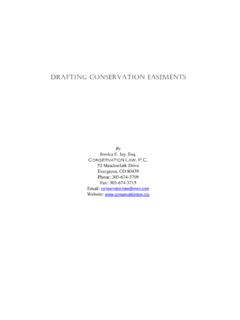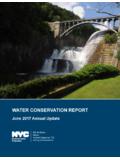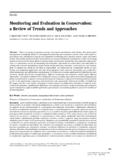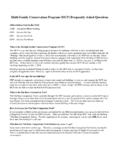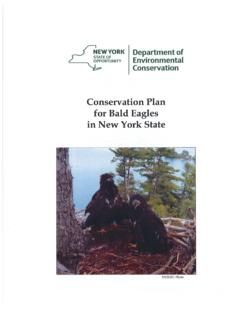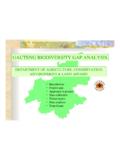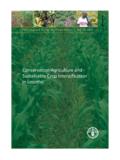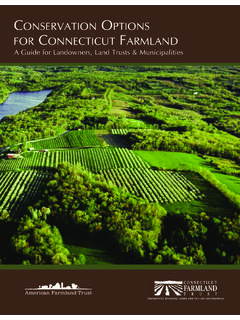Transcription of In vivo conservation of animal genetic resources
1 GuidelinesISSN 1810-070814 FAO animal PRODUCTION AND HEALTH14 FAOIn vivo conservation of animal genetic resources - The Global Plan of Action for animal genetic resources , adopted in 2007, is the first internationally agreed framework for the management of biodiversity in the livestock sector. It calls for the development of technical guidelines to support countries in their implementation efforts. Guidelines on the Preparation of national strategies and action plans for animal genetic resources were published in 2009 and are being complemented by a series of guideline publications addressing specific technical of animal genetic resources ensuring that these valuable resources remain available for future use by livestock breeders is one of the four strategic priority areas of the Global Plan of Action.
2 These guidelines focus on conservation in vivo , maintaining live populations rather than storing frozen genetic material. They complement separate guidelines on Cryoconservation of animal genetic resources published in the same series. They have been endorsed by the Commission on genetic resources for Food and vivo conservation encompasses a range of actions that can be taken to ensure the survival of livestock breeds or populations that are threatened with extinction. These guidelines address both in situ conservation (supporting the continued use of threatened breeds in the livestock production systems where they have traditionally been raised) and ex situ conservation (maintenance of populations at sites such as conservation farms and zoos).
3 As well as providing a wealth of information on breeding strategies for small at-risk populations, the guidelines provide advice on how to develop an effective and well-targeted national conservation strategy. They also discuss a number of specific strategies that can be employed to promote greater self-sustainability in at-risk breeds, including establishing community-based conservation programmes, promoting niche marketing and livestock-related cultural activities, and capitalizing on the use of grazing animals in landscape management and nature conservation . IN vivo CONSERVATIONOF animal genetic RESOURCESFAOANIMAL PRODUCTION AND HEALTHCOMMISSION ON genetic resources FOR FOOD AND AGRICULTUREFOOD AND AGRICULTURE ORGANIZATION OF THE UNITED NATIONSRome, 201314guidelinesIN vivo CONSERVATIONOF animal genetic RESOURCESR ecommended CitationFAO.
4 2013. In vivo conservation of animal genetic animal Production and Health Guidelines. No. 14. designations employed and the presentation of material in this information product do not imply the expression of any opinion whatsoever on the part of the Food and Agriculture Organization of the United Nations (FAO) concerning the legal or development status of any country, territory, city or area or of its authorities, or concerning the delimitation of its frontiers or boundaries. The mention of specific companies or products of manufacturers, whether or not these have been patented, does not imply that these have been endorsed or recommended by FAO in preference to others of a similar nature that are not views expressed in this information product are those of the author(s) and do not necessarily reflect the views or policies of 978-92-5-107725-2 (print)E-ISBN 978-92-5-107726-9 (PDF) FAO 2013 FAO encourages the use, reproduction and dissemination of material in this information product.
5 Except where otherwise indicated, material may be copied, downloaded and printed for private study, research and teaching purposes, or for use in non-commercial products or services, provided that appropriate acknowledgement of FAO as the source and copyright holder is given and that FAO s endorsement of users views, products or services is not implied in any requests for translation and adaptation rights, and for resale and other commercial use rights should be made via or addressed to information products are available on the FAO website ( ) and can be purchased through iiiContentsForeword ixAcknowledgements xiAbbreviations and acronyms xiiiGlossary of selected terms xvUser guidance xxisection 1 Reviewing the roles of animal genetic resources and options for their conservation 1inventorizing species.
6 Breeds and their functions 3 Describing the dynamics of the livestock sector 10 Reviewing the status and trends of animal genetic resources 12identifying reasons for the loss of animal genetic diversity 14identifying objectives for conservation 17 Reviewing the status of each breed and developing management strategies 20comparing conservation strategies 25 References 29section 2 Identifying breeds at risk 31 Determining risk status 33 References 56section 3 Determining the conservation value of a breed 57overview 59 Accounting for factors other than risk status 60 Using information from genetic markers 72 References 84section 4 Choosing the appropriate conservation methods 87 Matching breeds and conservation methods 89 Reference 94 Recommended CitationFAO.
7 2013. In vivo conservation of animal genetic animal Production and Health Guidelines. No. 14. designations employed and the presentation of material in this information product do not imply the expression of any opinion whatsoever on the part of the Food and Agriculture Organization of the United Nations (FAO) concerning the legal or development status of any country, territory, city or area or of its authorities, or concerning the delimitation of its frontiers or boundaries. The mention of specific companies or products of manufacturers, whether or not these have been patented, does not imply that these have been endorsed or recommended by FAO in preference to others of a similar nature that are not views expressed in this information product are those of the author(s) and do not necessarily reflect the views or policies of 978-92-5-107725-2 (print)E-ISBN 978-92-5-107726-9 (PDF) FAO 2013 FAO encourages the use, reproduction and dissemination of material in this information product.
8 Except where otherwise indicated, material may be copied, downloaded and printed for private study, research and teaching purposes, or for use in non-commercial products or services, provided that appropriate acknowledgement of FAO as the source and copyright holder is given and that FAO s endorsement of users views, products or services is not implied in any requests for translation and adaptation rights, and for resale and other commercial use rights should be made via or addressed to information products are available on the FAO website ( ) and can be purchased through section 5 Organizing the institutions for in vivo conservation 95overview 97involving livestock keepers in community-based conservation 99establishing a breeders association 109 Auditing a breeders association and its activities 121establishing a centralized ex situ conservation programme 125establishing a dispersed ex situ conservation programme 129 References 133section 6 Designing the conservation programme 135 Maintaining genetic variability within small populations 137 References
9 155section 7 Establishing a breeding programme for conservation and sustainable use 157overview 159choosing a breeding strategy 161optimizing selection response and genetic variability in small populations 169cross-breeding for enhanced production 177 References 188section 8 Increasing the value and sustainability of conserved breeds 191identifying sustainable use options for breeds under conservation 193 Preparing a Biocultural community Protocol 197implementing a role model breeders programme 203capitalizing on niche market production 207enhancing value through ties to geographical origin or cultural significance 214capitalizing on the roles of livestock in providing ecosystem services 222capitalizing on the societal and cultural functions of livestock 226 References 231 Annexoverview of sections, tasks and actions 235 vBoxes 1.
10 The definition of the term breed 3 2. Registration of livestock breeds in India 8 3. Colour sidedness: an example of genetic diversity conserved for research 19 4. SWOT analysis of Eastern Finncattle 22 5. SWOT analysis of the Java chicken in the United States of America 23 6. Growth rate and dynamics of population size 34 7. Basic rules for computing effective population size 36 8. Estimation of population growth rate 41 9. Analysis of population data an example 4210. Unique alleles allow the Araucana chicken of Chile to produce natural Easter eggs 6111. Botfly resistance in the Blanco Orejinegro cattle of Colombia 6212. Values of animal genetic resources 6513. Using choice models to value and rank breeds for conservation 6714. Use of a simple index to prioritize three breeds for conservation 7015.











